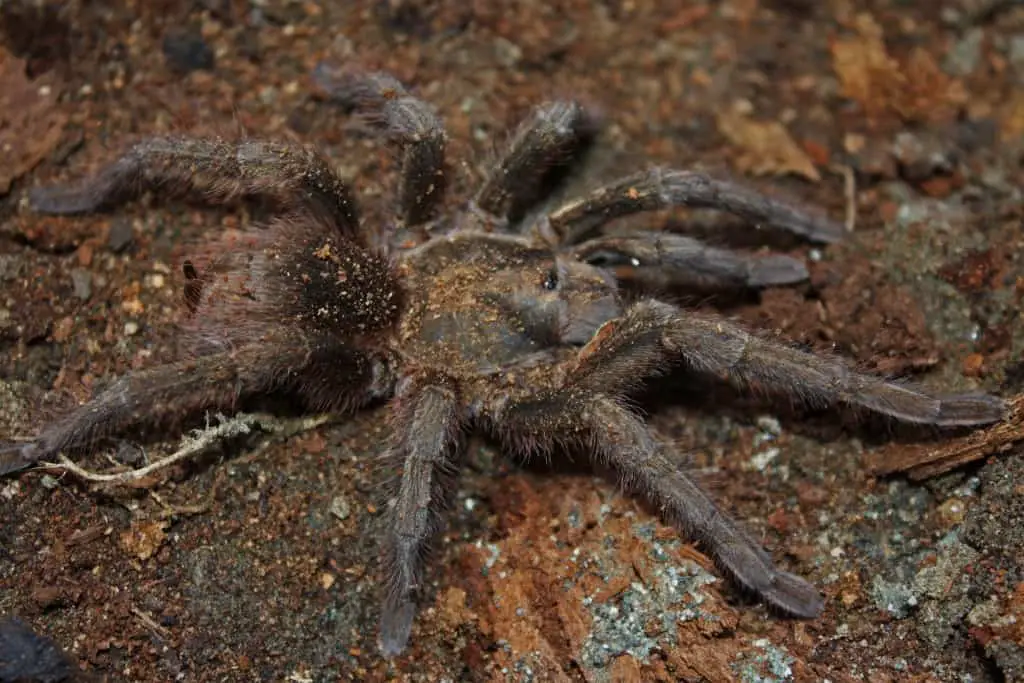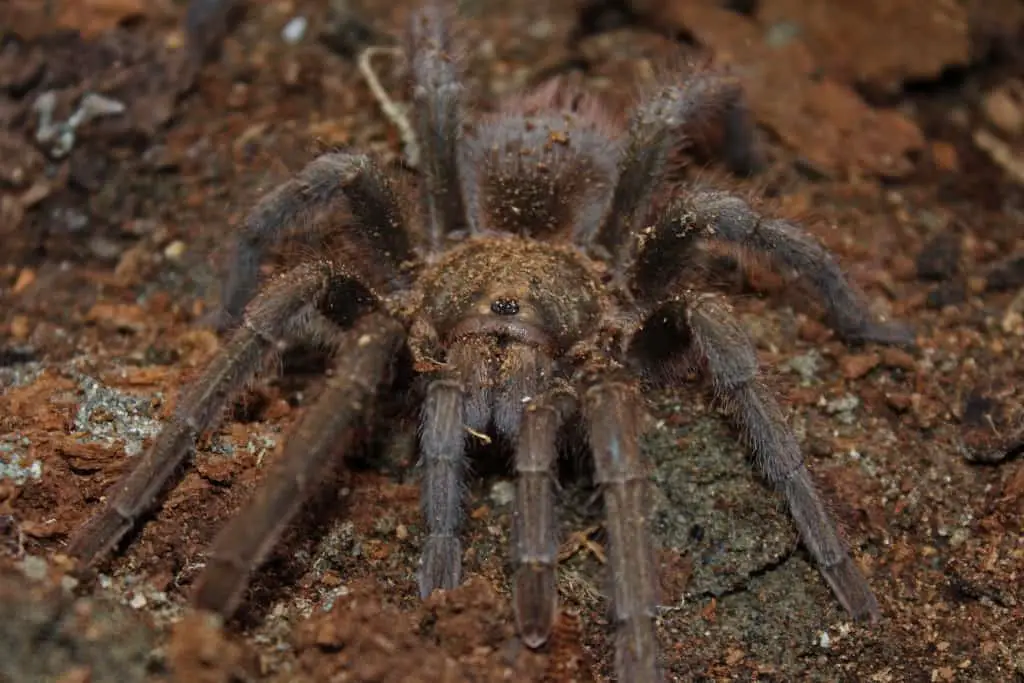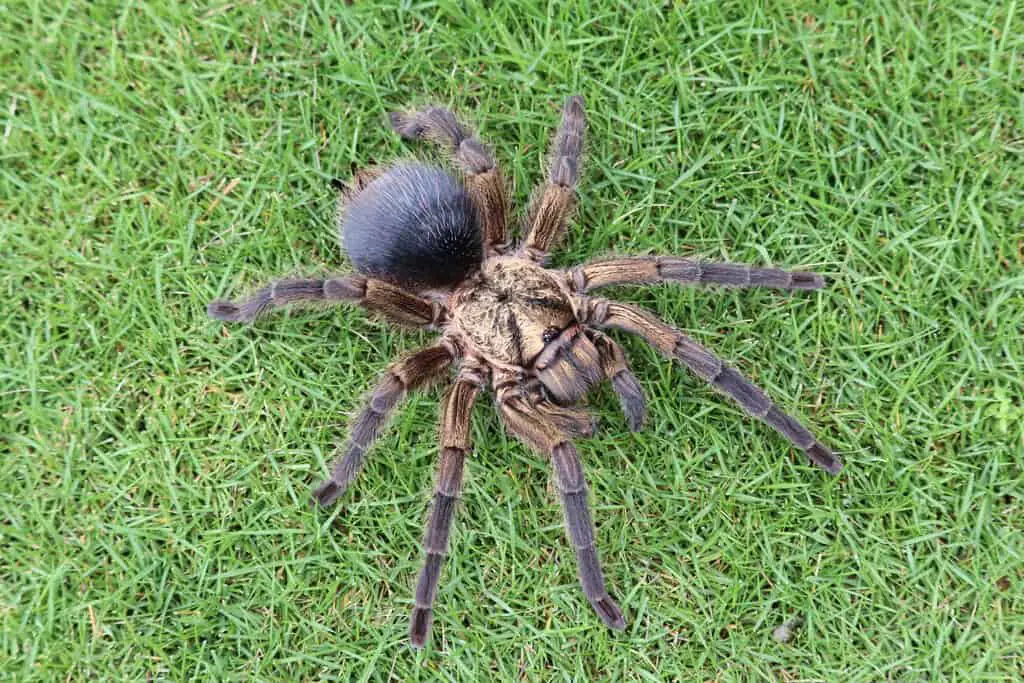The Cuban Bronze Tarantula is a New World tarantula that’s slowly but surely gaining popularity among tarantula fans in America. It has a dark appearance and can grow to a size of over 7 inches in length. If you’re considering taking this spider into your home, keep reading to learn everything you need to know about this fantastic species.
Cuban Bronze Tarantula Care Sheet
| Name of Species | Phormictopus auratus |
| Family | Theraphosidae |
| Experience level | Intermediate |
| Type | Terrestrial |
| Temperature requirement | 70-80 Fahrenheit |
| Temperament | Hardy, feisty, defensive |
| Color | Bronze |
| Native location | Cuba |
| Lifespan | Females 15 years; males 4 to 5 years |
| Size | 7 inches |
| Diet | Insects; crickets & roaches |
| Minimum tank size | 10 gallons is ideal |
Cuban Bronze Tarantula Overview

As the name suggests, the Cuban Bronze tarantula originates from Cuba. They’re quite feisty spiders that are known for their strong feeding response, which is one of the reasons why they’re quite a popular species.
They’re a terrestrial species which means that in the wild they spend their time on the ground rather than in the trees. They also have a tendency to burrow. Furthermore, since they’re a New World Tarantula, they have sharp urticating hairs which they can throw when they feel threatened.
Price
You should expect to spend between $60 and $150 when buying a Cuban Bronze Tarantula.
Typically, females are on the more expensive side, which makes sense because they have a lifespan that’s about 3 times as long.
Slings, the name for baby tarantulas, are often the least expensive but are not suitable for everyone because they require more care. Especially for people who are new to tarantula husbandry buying a sling is not recommended.
It’s unlikely that you will find one of these beautiful spiders are a local pet store, but it’s worth checking your local reptile dealer if you have any nearby. Typically, online breeders are your best bet. Do keep in mind that the distance between you and the breeder can significantly impact the total price.
Do not forget that you will also need to purchase a tank and that there are also some ongoing costs involved with owning one of these tarantulas such as buying food and substrate.
Behavior and Temperament
The Cuban Bronze Tarantula has a reputation as being defensive and quite feisty. They’re often described as having a bad attitude, which is why they’re not recommended for first-time owners. They can move quite quickly and it’s not unheard of for them to use their fangs when they feel threatened. On a positive note, they seem quite reluctant to throw their urticating hairs.
While their feisty temperament can make caring for them a bit more challenging than other species, it also has its benefits.
One thing that the Cuban Bronze is often praised for is its feeding fervor. They attack their prey with a determination and ferociousness that’s not often seen in other species. This makes the feeding process a joy to watch for many owners.
Of course, this feisty attitude can also be a drawback, and being on the other side of their bad attitude and fangs is not a whole lot of fun. Luckily, once they adapt to their environment and owner this should be less of a problem.
Appearance & Varieties

The Cuban Bronze tarantula has a brown/bronze carapace. One interesting thing about their appearance is that the slings have a metallic blue sheen. This blue color fades once they get older and makes way for the bronze tones that the tarantula was named after.
They grow quite quickly and will molt very regularly and will gain quite a bit of size between each molt.
Caring for a Cuban Bronze Tarantula
Tank Size
Your Cuban Bronze ideally needs a tank that’s 10 gallons in size. Smaller tanks can also work, as long as they’re deep enough to have space for a good layer of substrate.
Since this is a terrestrial tarantula they’re not fond of climbing, so that’s not something you need to accommodate for.
Substrate
The Cuban Bronze needs at least 6 inches of substrate to feel safe and secure. This is enough to allow them to burrow.
They need a moist environment, so coconut fibers are recommended as substrate because they hold moisture well. On top of that, it’s soft and doesn’t contain dust.
Temperature
Cuban Bronze Tarantulas thrive at temperatures between 70 and 80 degrees Fahrenheit. Higher temperatures can lead to faster growth.
Humidity
The recommended humidity level for their enclosure is around 70% to 80%. This humidity level combined with the aforementioned temperature closely simulates their natural environment, making it ideal for them to thrive.
Having adequate humidity is important to ensure that they can molt without issue. You can keep the humidity high by dampening the substrate.
Tank Decor
The Cuban Bronze Tarantula does not require a whole lot of accessories in their cage. They’re very minimalistic and only need a few natural rocks and plants to feel at home.
Of course, while tarantulas do not drink a whole lot, they do need access to water at all times. Make sure that they have a bowl of clean fresh water in their cage so that they can drink when needed.
Feeding your Cuban Bronze Tarantula
Feeding time is something that many Cuban Bronze owners look forward to. They have quite a simple diet consisting of insects. Crickets and roaches are easy to acquire from a local pet/reptile supply store and are favorites of these tarantulas.
When feeding, it’s important to only use captive-bred prey insects to avoid parasites.
Health & lifespan

Cuban Bronze tarantulas do not have any notable health problems that you need to look out for. In the wild, they of course have their predators, but in captivity, there’s not much to threaten them. This gives them a very long lifespan.
Females can live for up to 15 years, whereas males typically live for around 5 years. This is a long commitment and something you need to be prepared for when deciding to buy one of these animals.
Breeding
You can start breeding the Cuban Bronze once it’s over 4 weeks old and has started molting. To begin the breeding process, place a well-fed female and a male in their own separate terrariums next to each other so that they can see each other.
After a few days, place them in one terrarium together so that they can breed. Once they’ve bred, separate them immediately and put them back into their own enclosures.
After a few months, the female will create a cocoon for the eggs. A few weeks after that the eggs will hatch and hundreds of slings will be born.
Breeding is something that’s best left to experts. Do not try it at home if you do not know what you’re doing. You will end up with 100s of slings which will be difficult to find suitable homes for.
Final words: Is the Cuban Bronze Tarantula right for you?
If you’re looking for a feisty spider with an appetite that’s quite challenging to take care of, the Cuban Bronze might be a good fit for you. Their energetic nature and ferocious feeding frenzies make them beloved among people who are experienced tarantula handlers.
However, do be sure that you know what you’re getting into. This is by no means a beginner-friendly spider. If you’re new to tarantula husbandry, something like the Green Bottle Blue is a much better choice.
- How Long Do American Eskimo Dogs Live? Important Factors and Care Tips - September 29, 2023
- Do American Bulldogs Need Grooming? Essential Tips and Care Guidelines - September 29, 2023
- Do Bengal Cats Enjoy Playing? Essential Tips for Keeping Them Active - September 29, 2023